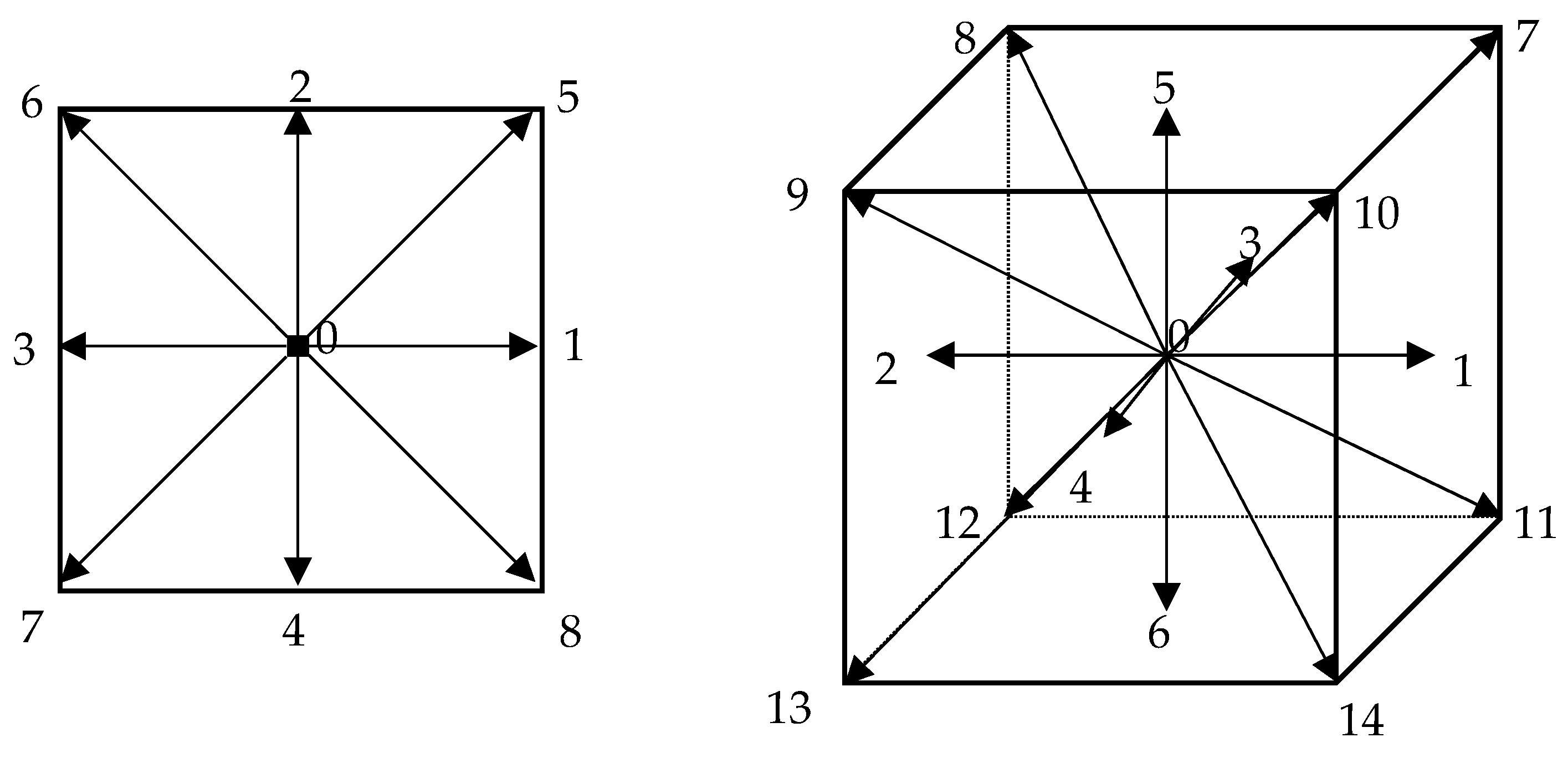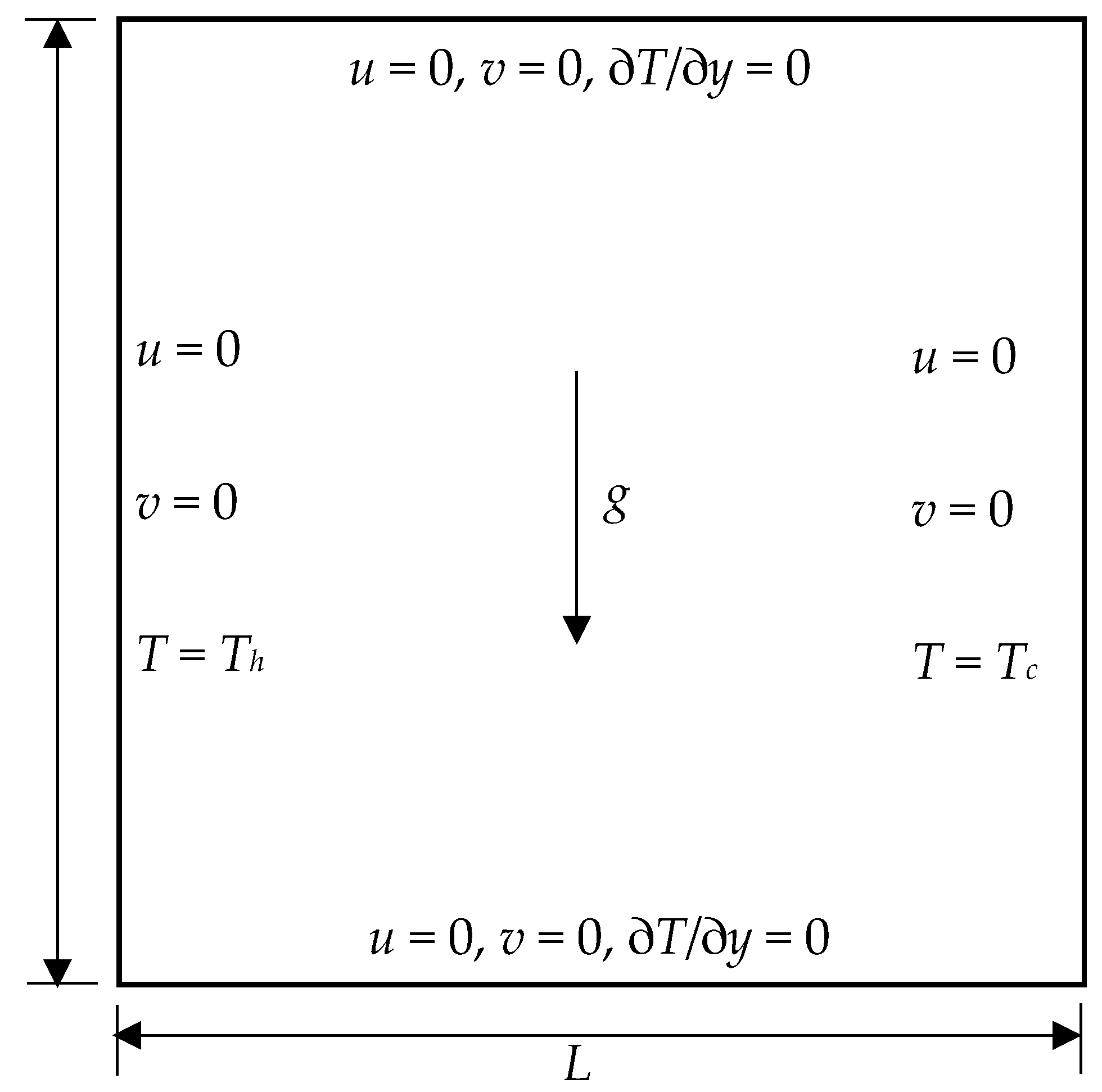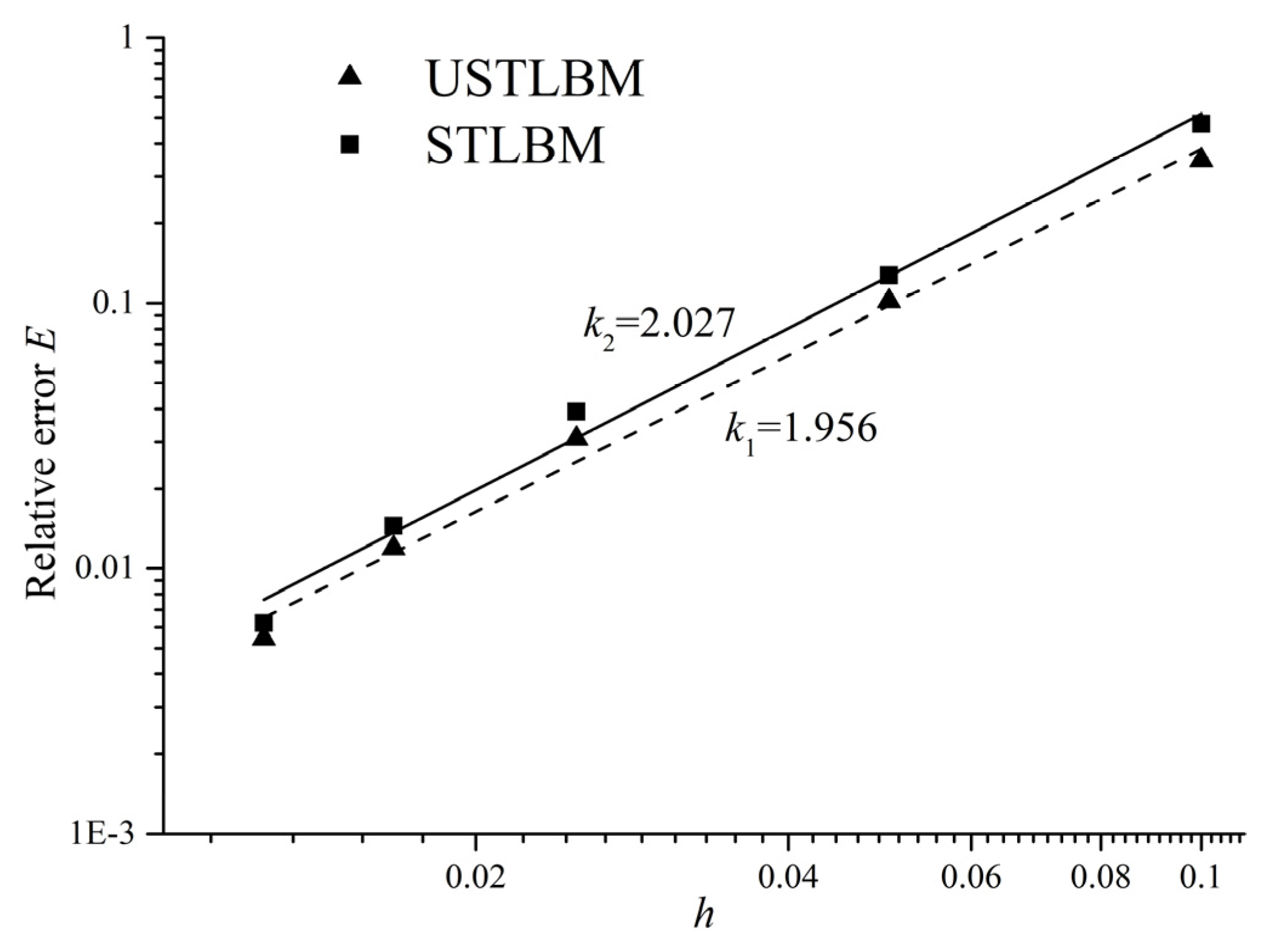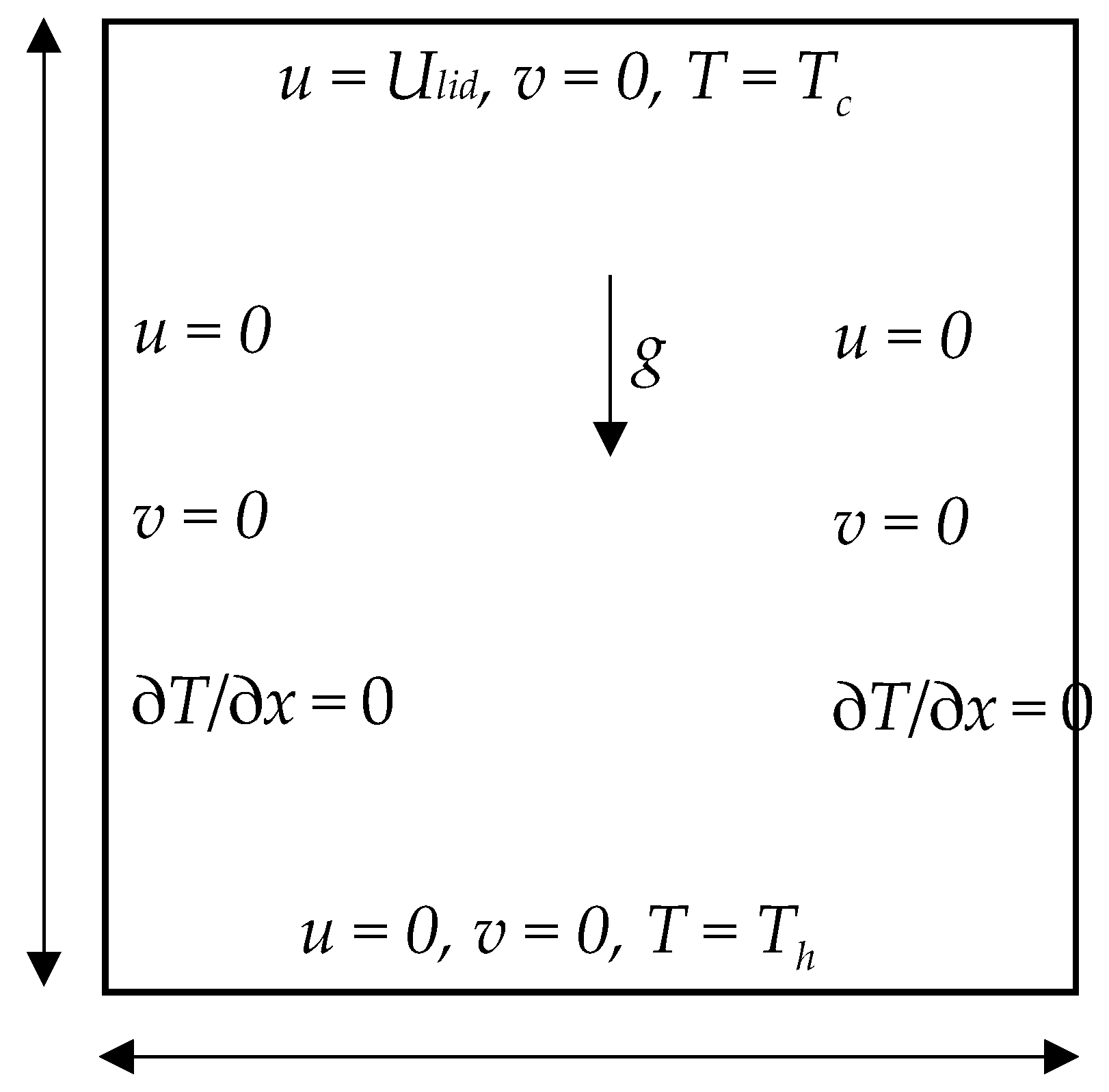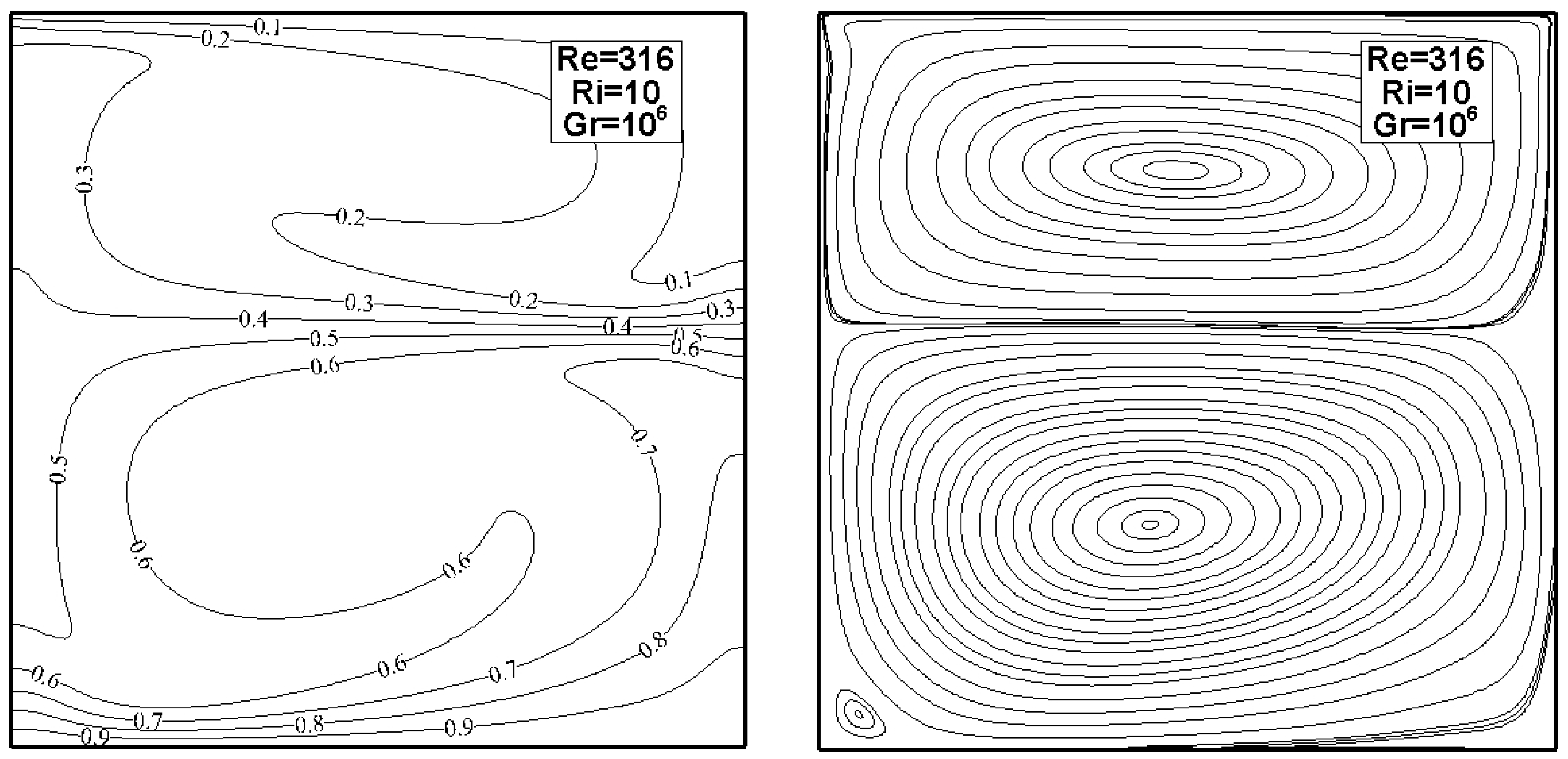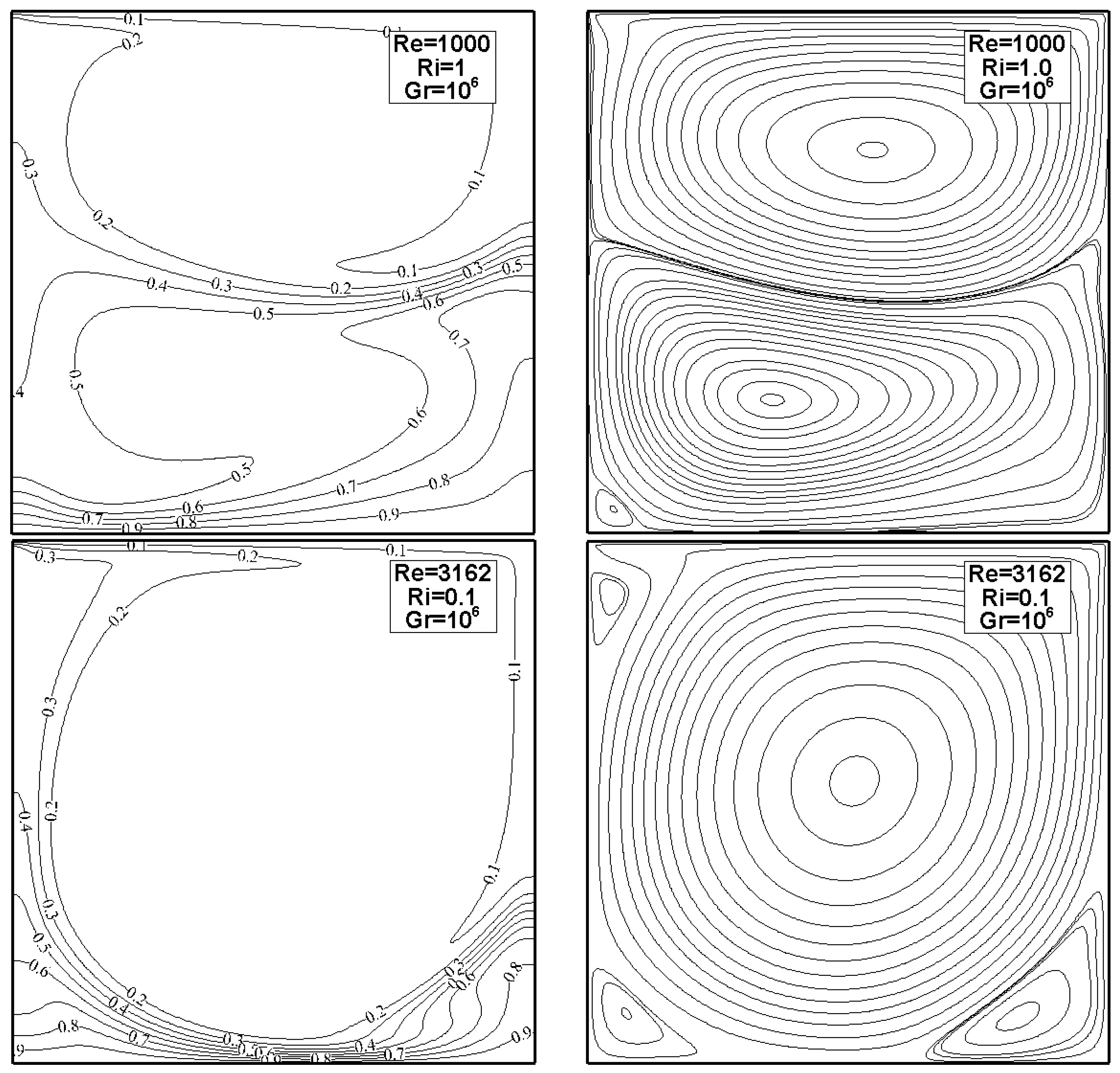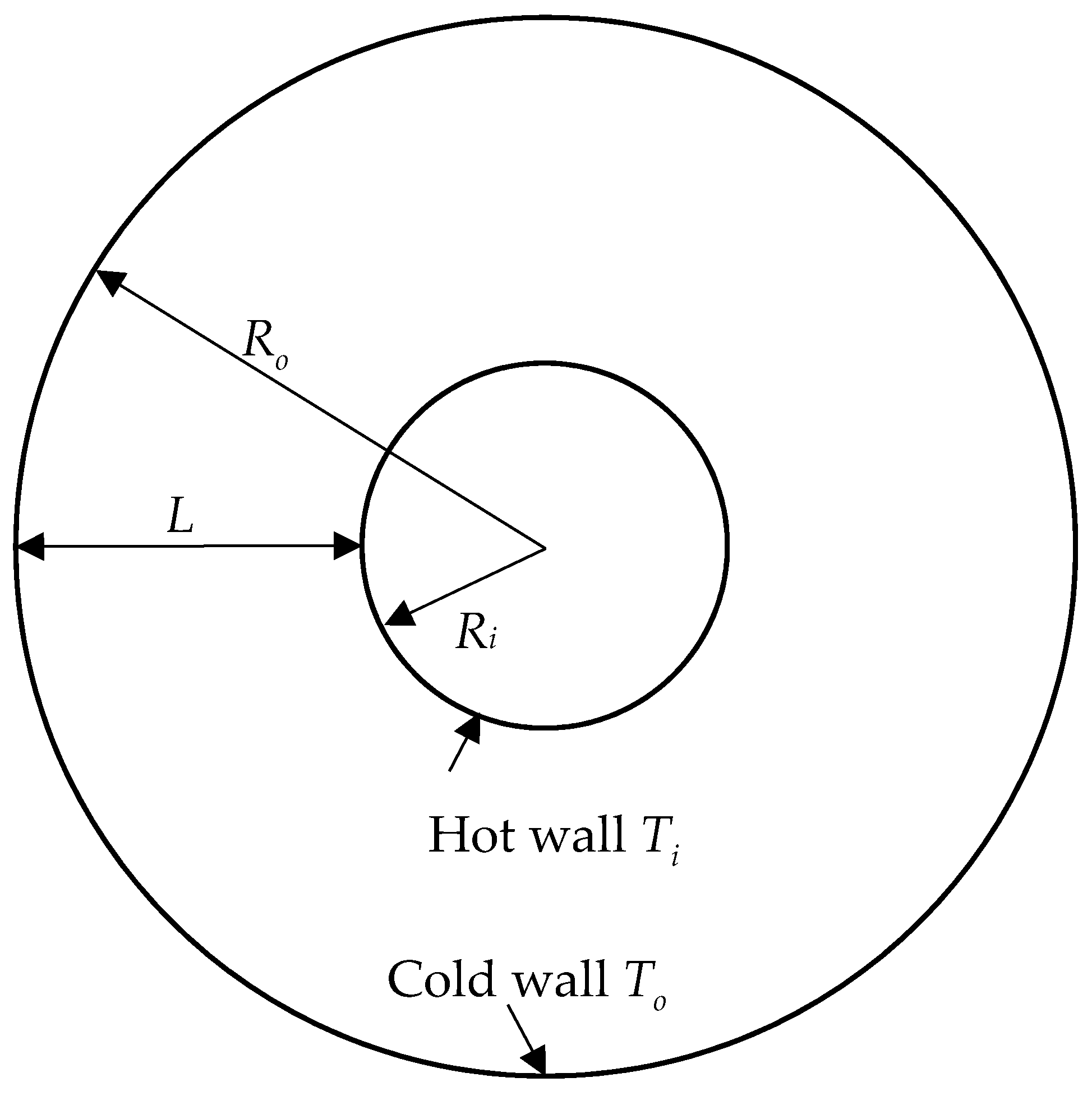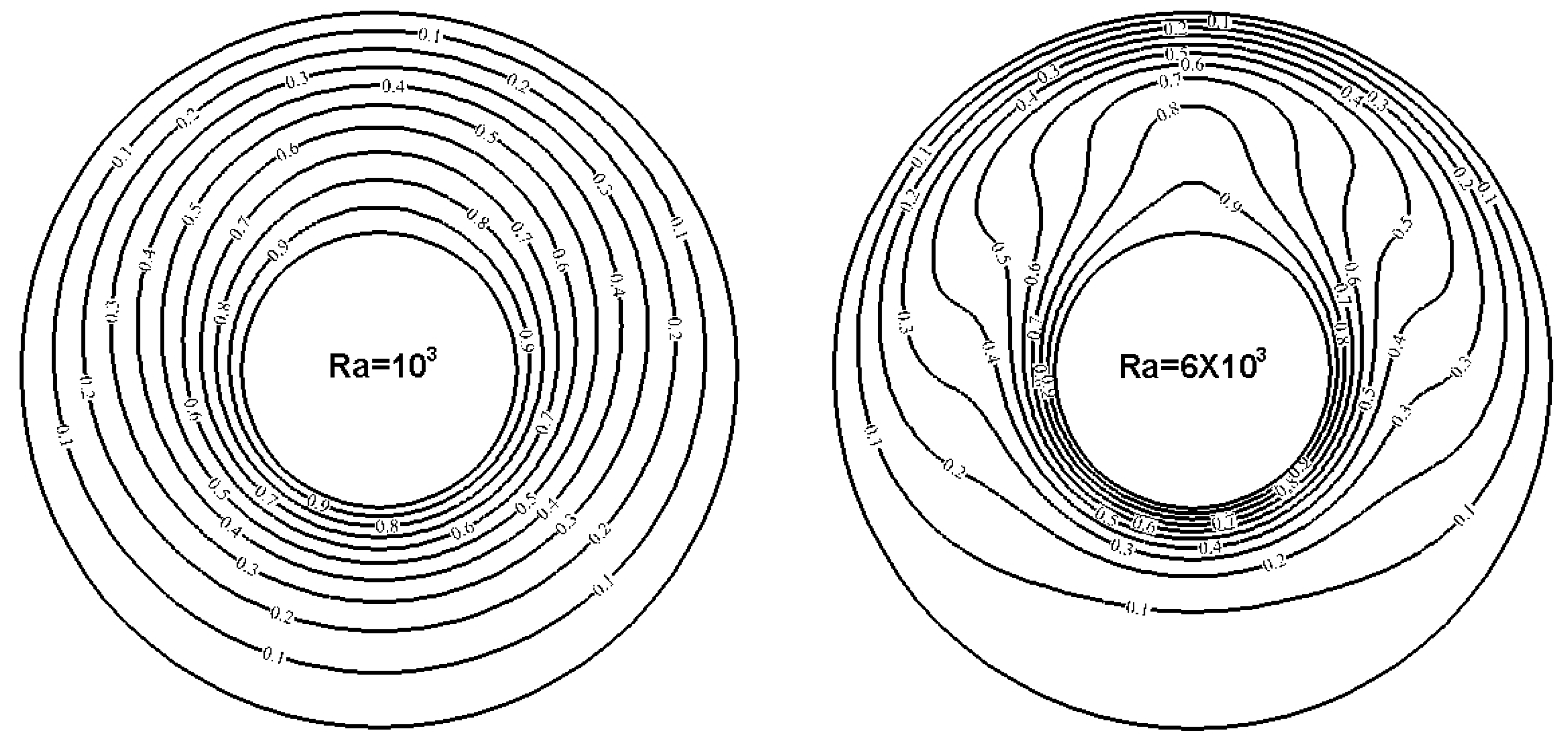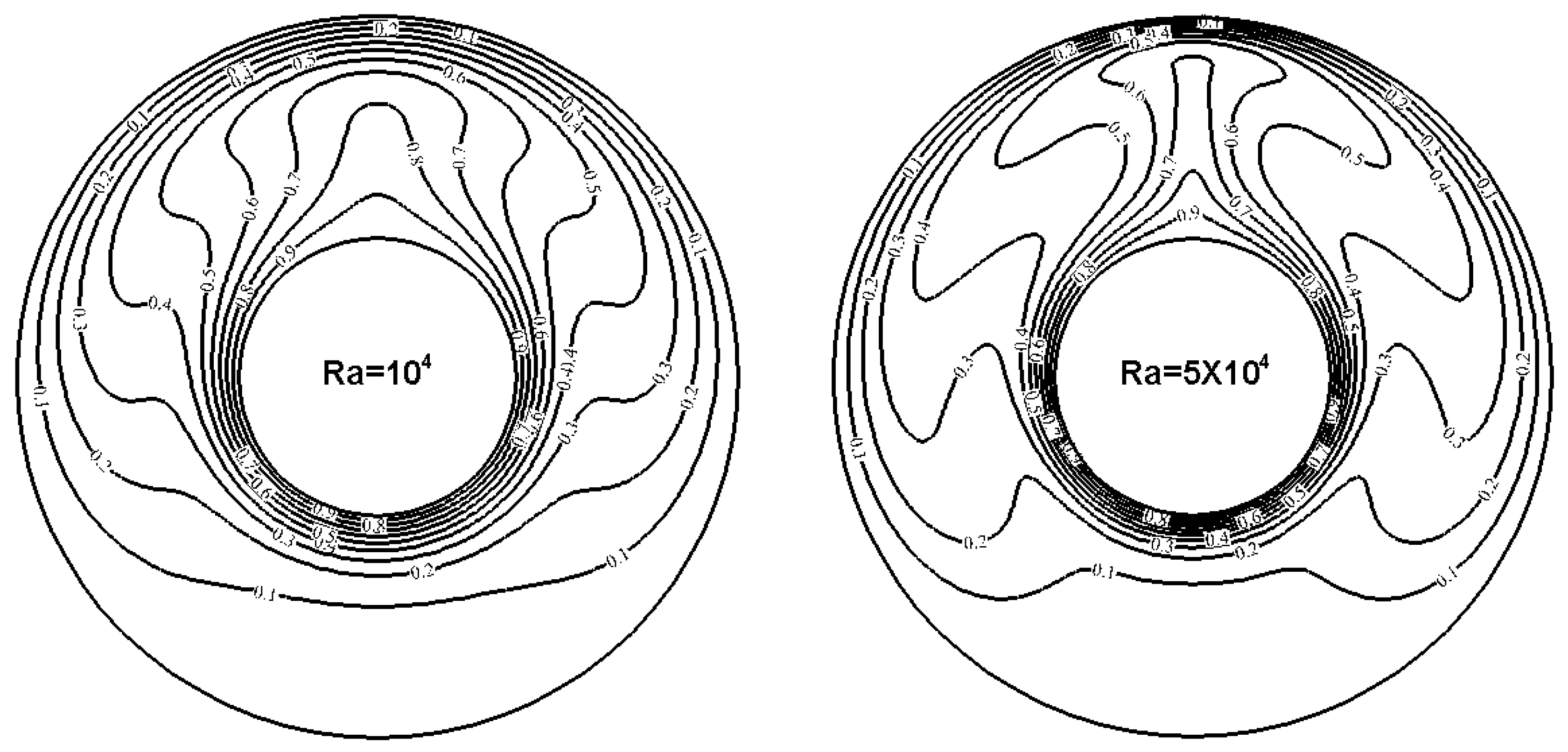3.1. Modifications on STLBM
The initial formulations in the corrector step are shown in Equations (27)–(29). Apparently, Equation (27) recovers Equation (20) exactly. In the present work, Equations (28) and (29) are, respectively, replaced by the following formulas
To present theoretical analysis on the accuracy, we start from non-equilibrium distribution functions involved in the above formulations. Performing Taylor-series expansion analysis on Equation (30) with third-order of truncated error gives
Equations (34) and (35) indicate that, with desired order of accuracy, the approximated non-equilibrium distribution functions in Equations (30) and (31) are at space/time level of (
r − 0.5
eαδt,
t − 0.5
δt). Such shifting in time and space favors our construction of a central-difference scheme both in space and in time, with which the second-order of accuracy can be guaranteed. Maintaining its location in time level, we further expand Equation (34) with respect to the space/time levels of (
r,
t − 0.5
δt), which gives
Substituting Equations (36) and (37) into Equation (32) leads to
Apparently, the first two terms on right hand side of Equation (38) represent the approximation of the space derivative term in Equation (21) with the second-order of accuracy in space. Meanwhile, the approximated space derivatives are defined at the time level of (t − 0.5δt), which represents a typical central difference scheme that ensures the second-order of accuracy in time marching. Through similar processes, it can also be proven that Equation (33) recovers Equation (22) with the second-order of accuracy both in time and in space.
3.2. Unconditionally Stable Thermal Lattice Boltzmann Method (USTLBM)
With the modifications made on previous simplified thermal lattice Boltzmann method (STLBM), formulations of the present unconditionally stable thermal lattice Boltzmann method (USTLBM) are shown as follows:
- Predictor step:
- Corrector step:
where the non-equilibrium terms are evaluated by
To ensure the second-order of accuracy in time, the external force term
FE should be defined on (
r,
t − 0.5
δt). According to Boussinesq approximation shown in Equation (23), this term is approximated by
Since T(r,t) can be solved firstly and then substituted into Equation (47) in the same time step, the equations are decoupled and the explicitness of the scheme is ensured.
As discussed above, USTLBM is an improved version of STLBM and is a truly second-order method. Nevertheless, the basic idea of USTLBM is similar to that of STLBM, which is to reconstruct solutions to macroscopic governing equations within LBM framework. Such characteristics grant USTLBM advantages from both STLBM and standard LBM. On one hand, USTLBM maintains the simplicity and explicitness, and ensures the second-order of accuracy in time and space as standard LBM does. On the other hand, USTLBM directly updates macroscopic variables rather than distribution functions, which greatly lowers virtual memories and facilitates implementation of physical boundary conditions. Moreover, as its name indicates, USTLBM can be theoretically proven to be unconditionally stable, which will be discussed in detail in following sections.
3.3. Boundary Conditions
In its computational process, USTLBM calls for boundary values of both macroscopic variables and non-equilibrium distribution functions. The physical boundary condition, which is related to macroscopic variables, can be directly implemented. Specifically, Dirichlet boundary condition can be imposed by artificially assigning boundary values of macroscopic variables on boundary meshes; and Neumann boundary condition can be fulfilled by adopting information on several inner layers of meshes to achieve desired order of accuracy.
Boundary values of non-equilibrium distribution functions are required in the corrector step of USTLBM, as shown in Equations (43) and (44). It has been proven in previous studies that the non-equilibrium extrapolation scheme can ensure the second order of accuracy in space [
17]. In this treatment, the boundary values of non-equilibrium distribution functions are set equal to those on the first inner layer of mesh points. Such boundary treatment can be flexibly applied in uniform and non-uniform meshes, and will be used in the present method in determining boundary values of non-equilibrium terms.
3.4. Stability Analysis
Theoretical analysis for the stability of lattice Boltzmann method (LBM) was firstly conducted by Sterling and Chen [
18]. It was found that standard LBM suffers from numerical instability when the single relaxation parameter
τ is close to 0.5, which indicates that standard LBM is not suitable to problems at high Reynolds numbers. The recently developed simplified thermal lattice Boltzmann method (STLBM), on the other hand, performs very well in numerical stability. Through von Neumann stability analysis, it can be proven that STLBM is unconditionally stable [
12]. The USTLBM proposed in this paper can be regarded as an improved version of STLBM that ensures higher order of accuracy in time. In this section, we use von Neumann stability analysis to study its stability performance. For the ease of analysis, we take the two-dimensional formulations as the example here. Analysis on the three-dimensional formulations can be carried out through similar processes, and same conclusions can be obtained.
To begin with, the following macroscopic variables are defined:
The vector of these variables is then written as
The equilibrium distribution functions Equations (3) and (4) are functions of the macroscopic variables, which can be written as
where
y1α,
y2α,
y3α and
y4α denote the functional values of
y1,
y2,
y3 and
y4 at the space/time level of (
r-
eα, t-
δt), respectively. Substituting Equations (50) and (51) into the expressions for the intermediate density, momentum and energy (Equations (39)–(41)) gives a set of nonlinear algebraic equations
Y* = F(
Yn). To linearize the problem to perform von Neumann stability analysis, the obtained equations are differentiated with respect to
y1,
y2,
y3 and
y4, which leads to
where
Y* = (
y1*,
y2*,
y3*,
y4*)
T; and the superscript
n represents the time level. For illustration purposes, we take the term [
∂y2*/
∂y2]
n to elaborate the analyzing process:
In von-Neumann stability analysis, the variables are approximated by the Fourier serial expansions [
2]. Consider a random component of the variables encountered here, which can be written as
In addition, note that the following isotropic properties of the lattice tensors are generally applicable within LBM framework:
Substituting Equations (54) and (55) into Equation (53), we can derive that
Following similar processes shown in Equations (53)–(56), we can find the values of all terms inside the brackets in Equation (52) (i.e., [
∂yi*/
∂yj]
n); and the equation can be simplified as
In the corrector step, it is shown in Equation (42) that no correction is performed on the density. Therefore, we can simply derive that
Next, we still take the variable
y2 to illustrate the analyzing process in the corrector step. According to Equations (40), (43), and (45), we have
Substitution of the equilibrium distribution based on the intermediate macroscopic variables into the second term on RHS of the above equation gives a nonlinear algebraic formula of
where the subscript “−
α” represents the space level of (
r +
eαδt). Similar to the procedures conducted in the corrector step, here we linearize the formula by differentiating it, which gives
Following similar processes shown in Equations (53)–(56), the values of terms inside brackets can be evaluated. Subsequently, Equation (61) is simplified as
Differentiating Equation (59) and substituting Equations (54) and (62) into it eventually gives
Other variables in the corrector step can be analyzed through similar procedures to derive the following relationship:
Thus, the overall stability analysis of USTLBM can be written in the matrix form of
Apparently, all eigenvalues in the characteristic matrix are 1. Therefore, it is proven that USTLBM proposed in this paper is theoretically unconditionally stable.
Through the above von Neumann stability analysis, it turns out that USTLBM maintains the merit of STLBM in numerical stability; therefore, both of them are advantageous over the standard LBM. Meanwhile, considering its advantage in temporal accuracy, USTLBM is more competitive than STLBM in the perspective of numerical accuracy.
